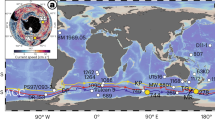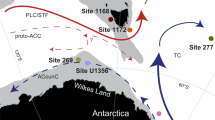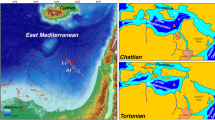Abstract
Earth’s mightiest ocean current, the Antarctic Circumpolar Current (ACC), regulates the exchange of heat and carbon between the ocean and the atmosphere1, and influences vertical ocean structure, deep-water production2 and the global distribution of nutrients and chemical tracers3. The eastward-flowing ACC occupies a unique circumglobal pathway in the Southern Ocean that was enabled by the tectonic opening of key oceanic gateways during the break-up of Gondwana (for example, by the opening of the Tasmanian Gateway, which connects the Indian and Pacific oceans). Although the ACC is a key component of Earth’s present and past climate system1, the timing of the appearance of diagnostic features of the ACC (for example, low zonal gradients in water-mass tracer fields4,5,6,7) is poorly known and represents a fundamental gap in our understanding of Earth history. Here we show, using geophysically determined positions of continent–ocean boundaries8, that the deep Tasmanian Gateway opened 33.5 ± 1.5 million years ago (the errors indicate uncertainty in the boundary positions). Following this opening, sediments from Indian and Pacific cores recorded Pacific-type neodymium isotope ratios, revealing deep westward flow equivalent to the present-day Antarctic Slope Current. We observe onset of the ACC at around 30 million years ago, when Southern Ocean neodymium isotopes record a permanent shift to modern Indian–Atlantic ratios. Our reconstructions of ocean circulation show that massive reorganization and homogenization of Southern Ocean water masses coincided with migration of the northern margin of the Tasmanian Gateway into the mid-latitude westerly wind band, which we reconstruct at 64° S, near to the northern margin. Onset of the ACC about 30 million years ago coincided with major changes in global ocean circulation9 and probably contributed to the lower atmospheric carbon dioxide levels that appear after this time10.
This is a preview of subscription content, access via your institution
Access options
Subscribe to this journal
Receive 51 print issues and online access
$199.00 per year
only $3.90 per issue
Buy this article
- Purchase on Springer Link
- Instant access to full article PDF
Prices may be subject to local taxes which are calculated during checkout


Similar content being viewed by others
References
Anderson, R. F. et al. Wind-driven upwelling in the Southern Ocean and the deglacial rise in atmospheric CO2 . Science 323, 1443–1448 (2009)
Cox, M. D. An idealized model of the world ocean. 1. The global-scale water masses. J. Phys. Oceanogr. 19, 1730–1752 (1989)
Toggweiler, J., Russell, J. & Carson, S. Midlatitude westerlies, atmospheric CO2, and climate change during the ice ages. Paleoceanography 21, PA2005 (2006)
Jeandel, C. Concentration and isotopic composition of Nd in the South Atlantic Ocean. Earth Planet. Sci. Lett. 117, 581–591 (1993)
Stichel, T., Frank, M., Rickli, J. & Haley, B. The hafnium and neodymium isotope composition of the Atlantic sector of the Southern Ocean. Earth Planet. Sci. Lett. 317–318, 282–294 (2011)
Basak, C., Pahnke, K., Frank, M., Lamy, F. & Gersonde, R. Neodymium isotopic characterization of Ross Sea Bottom Water and its advection through the southern South Pacific. Earth Planet. Sci. Lett. 419, 211–221 (2015)
Albarède, F., Goldstein, S. L. & Dautel, D. The neodymium isotopic composition of manganese nodules from the Southern and Indian oceans, the global oceanic neodymium budget, and their bearing on deep ocean circulation. Geochim. Cosmochim. Acta 61, 1277–1291 (1997)
Williams, S. E., Whittaker, J. M. & Müller, R. D. Full-fit, palinspastic reconstruction of the conjugate Australian-Antarctic margins. Tectonics 30, 21 (2011)
Katz, M. E. et al. Impact of Antarctic Circumpolar Current development on late Paleogene ocean structure. Science 332, 1076–1079 (2011)
Pagani, M. et al. The role of carbon dioxide during the onset of Antarctic glaciation. Science 334, 1261–1264 (2011)
Stickley, C. E. et al. Timing and nature of the deepening of the Tasmanian Gateway. Paleoceanography 19, PA4027 (2004)
Cande, S. C. & Mutter, J. C. A revised identification of the oldest sea-floor spreading anomalies between Australia and Antarctica. Earth Planet. Sci. Lett. 58, 151–160 (1982)
Hill, P. J. & Exon, N. F. in The Ceonzoic Southern Ocean: Tectonics, Sedimentation and Climate Change Between Australia and Antarctica (eds Exon, N. F., Kennet, J. P. & Malone, M. ) 19–42 (Geophysical Monograph 151, American Geophysical Union, 2004)
Bijl, P. K. et al. Eocene cooling linked to early flow across the Tasmanian Gateway. Proc. Natl Acad. Sci. USA 110, 9645–9650 (2013)
Gille, S. T. Float observations of the Southern Ocean. Part I: estimating mean fields, bottom velocities, and topographic steering. J. Phys. Oceanogr. 33, 1167–1181 (2003)
Hill, D. J. et al. Paleogeographic controls on the onset of the Antarctic circumpolar current. Geophys. Res. Lett. 40, 5199–5204 (2013)
Cande, S. C. & Stock, J. M. Pacific-Antarctic-Australia motion and the formation of the Macquarie Plate. Geophys. J. Int. 157, 399–414 (2004)
O’Neill, C., Müller, D. & Steinberger, B. On the uncertainties in hot spot reconstructions and the significance of moving hot spot reference frames. Geochem. Geophys. Geosyst. 6, Q04003 (2005)
Nelson, C. S. & Cooke, P. J. History of oceanic front development in the New Zealand sector of the Southern Ocean during the Cenozoic — a synthesis. NZ J. Geol. Geophys. 44, 535–553 (2001)
Martin, E. E. & Scher, H. D. Preservation of seawater Sr and Nd isotopes in fossil fish teeth: bad news and good news. Earth Planet. Sci. Lett. 220, 25–39 (2004)
Goldstein, S. L. & Hemming, S. R. in Treatise on Geochemistry Vol. 6 (eds Heinrich, H. D. & Turekian, K. K. ) 453–489 (Pergamon, 2003)
Dong, S., Sprintall, J., Gille, S. T. & Talley, L. Southern Ocean mixed-layer depth from Argo float profiles. J. Geophys. Res. 113, C06013 (2008)
Sijp, W. P., England, M. H. & Huber, M. Effect of the deepening of the Tasman Gateway on the global ocean. Paleoceanography 28, 18 (2011)
Stichel, T. et al. Sources and input mechanisms of hafnium and neodymium in surface waters of the Atlantic sector of the Southern Ocean. Geochim. Cosmochim. Acta 94, 22–37 (2012)
Hoernle, K. et al. Age and geochemistry of volcanic rocks from the Hikurangi and Manihiki oceanic Plateaus. Geochim. Cosmochim. Acta 74, 7196–7219 (2010)
Bindoff, N. L., Rosenberg, M. A. & Warner, M. J. On the circulation and water masses over the Antarctic continental slope and rise between 80 and 150 degrees E. Deep-Sea Res. II 47, 2299–2326 (2000)
Huber, M. et al. Eocene circulation of the Southern Ocean: was Antarctica kept warm by subtropical waters? Paleoceanography 19, PA4026 (2004)
van de Flierdt, T. et al. Deep and bottom water export from the Southern Ocean to the Pacific over the past 38 million years. Paleoceanography 19, PA1020 (2004)
Toggweiler, J. R. & Samuels, B. Effect of Drake Passage on the global thermohaline circulation. Deep-Sea Res. I 42, 477–500 (1995)
Orsi, A. H., Whitworth, T., III & Nowlin, W. D., Jr On the meridional extent and fronts of the Antarctic Circumpolar Current. Deep-Sea Res. I 42, 641–673 (1995)
Boyle, E. A. Cadmium, zinc, copper and barium in foraminifera tests. Earth Planet. Sci. Lett. 53, 11–35 (1981)
Boyle, E. A. & Keigwin, L. D. Comparison of Atlantic and Pacific paleochemical records for the last 215,000 years; changes in deep ocean circulation and chemical inventories. Earth Planet. Sci. Lett. 76, 135–150 (1985/86).
Scher, H. D. & Delaney, M. L. Breaking the glass ceiling for high resolution Nd isotope records in early Cenozoic paleoceanography. Chem. Geol. 269, 329–338 (2010)
Chavagnac, V. et al. Towards the development of a fossil bone geochemical standard: an inter-laboratory study. Anal. Chim. Acta 599, 177–190 (2007)
Ling, H. F. et al. Evolution of Nd and Pb isotopes in Central Pacific seawater from ferromanganese crusts. Earth Planet. Sci. Lett. 146, 1–12 (1997)
Ling, H.-F. et al. Differing controls over the Cenozoic Pb and Nd isotope evolution of deepwater in the central North Pacific Ocean. Earth Planet. Sci. Lett. 232, 345–361 (2005)
Scher, H. Stacking PEAT; a neodymium isotope stack for the Paleogene equatorial Pacific. Rendiconti Soc. Geol. Ital. 31, 191–192 (2014)
Scher, H. D. & Martin, E. E. Circulation in the Southern Ocean during the Paleogene inferred from neodymium isotopes. Earth Planet. Sci. Lett. 228, 391–405 (2004)
Scher, H. D., Bohaty, S., Zachos, J. C. & Delaney, M. L. Two-stepping into the icehouse: East Antarctic weathering during progressive ice-sheet expansion at the Eocene-Oligocene Transition. Geology 39, 383–386 (2011)
Scher, H. D., Bohaty, S. M., Smith, B. & Munn, G. Isotopic interogation of a suspected late Eocene glaciation. Paleoceanography 29, 628–644 (2014)
Martin, E. E. & Scher, H. A Nd isotopic study of southern sourced waters and Indonesian throughflow at intermediate depths in the Cenozoic Indian Ocean. Geochem. Geophys. Geosyst. 7, Q09N02 (2006)
Scher, H. D. & Martin, E. E. Timing and climatic consequences of the opening of Drake Passage. Science 312, 428–430 (2006)
Goldstein, S. J. & Jacobsen, S. B. The Nd and Sr isotopic systematics of river-water dissolved material — implications for the sources of Sd and Sr in seawater. Chem. Geol. 66, 245–272 (1987)
Goldstein, S. J. & Jacobsen, S. B. Nd and Sr isotopic systematics of river water suspended material; implications for crustal evolution. Earth Planet. Sci. Lett. 87, 249–265 (1988)
Taylor, S. R. & McLennan, S. M. The Continental Crust: Its Composition and Evolution (Blackwell, 1985)
Joseph, L. H., Rea, D. K. & van der Pluijm, B. A. Neogene history of the Deep Western Boundary Current at Rekohu sediment drift, Southwest Pacific (ODP Site 1124). Mar. Geol. 205, 185–206 (2004)
Stickley, C. E. et al. Late Cretaceous to Quaternary biomagnetostratigraphy of ODP Sites 1168, 1170, 1171, and 1172, Tasmanian Gateway. Proc. ODP Sci. Res http://www-odp.tamu.edu/publications/189_SR/111/111.htm (2004)
Fuller, M. & Touchard, Y. in The Cenozoic Southern Ocean. Tectonics, Sedimentation, and Climate Change between Australia and Antarctica (eds Exon, N., Kennett, J. P. & Malone, M. ) 63–78 (American Geophysical Union, 2004)
Lanyon, R., Varne, R. & Crawford, A. J. Tasmanian tertiary basalts, the Balleny plume, and opening of the Tasman sea (southwest Pacific-ocean). Geology 21, 555–558 (1993)
Quilty, P. G. Late Eocene foraminifers and palaeoenvironment, Cascade Seamount, southwest Pacific Ocean: implications for seamount subsidence and Australia-Antarctica Eocene correlation. Austral. J. Earth Sci. 48, 633–641 (2001)
Quilty, P. G. Eocene and younger biostratigraphy and lithofacies of the Cascade Seamount, East Tasman Plateau, southwest Pacific Ocean. Austral. J. Earth Sci. 44, 655–665 (1997)
Bouma, A. H. Sedimentology of Some Flysch Deposits: A Graphic Approach to Facies Interpretation (Elsevier, 1962)
Müller, R. D., Sdrolias, M., Gaina, C. & Roest, W. R. Age, spreading rates, and spreading asymmetry of the world's ocean crust. Geochem. Geophys. Geosyst. 9, Q04006 (2008)
Torsvik, T. H. et al. Phanerozoic polar wander, palaeogeography and dynamics. Earth Sci. Rev. 114, 325–368 (2012)
Torsvik, T. H., Steinberger, B., Cocks, L. R. M. & Burke, K. Longitude: linking Earth’s ancient surface to its deep interior. Earth Planet. Sci. Lett. 276, 273–282 (2008)
Acknowledgements
H.D.S. received support from an UTAS IMAS Visiting Scholarship and an EES travel grant while this manuscript was prepared, and was supported by the US National Science Foundation (NSF) award OCE 1155630. J.M.W. was supported by ARC grant DE140100376. M.L.D. was supported by NSF award OCE-0647876. This research used data and samples from the Ocean Drilling Program (ODP), which was sponsored by the NSF and participating countries under the management of Joint Oceanographic Institutions. GPlates is free software that is licensed for distribution under the GNU General Public License v2 (http://www.gplates.org). Researchers in the EarthByte group have made GPlates compatible data available, some of which were used in this study. We thank C. Moy, C. Riesselman, R. Rykaczewski and A. Winguth for discussions. M. Seton and W. Sijp provided feedback on an early version of the manuscript. J. Aggarwal, E. Bair, M. Frank and S. Sampson provided analytical support.
Author information
Authors and Affiliations
Contributions
H.D.S. and M.L.D. designed the research; J.M.W. and S.E.W. carried out plate-tectonic modelling and assessed error in the past positions of conjugate margins; H.D.S., J.C.L. and W.E.C.K. collected geochemical data. All authors contributed to interpreting the data and writing the paper.
Corresponding author
Ethics declarations
Competing interests
The authors declare no competing financial interests.
Extended data figures and tables
Extended Data Figure 1 Tectonic reconstructions of the Tasmanian Gateway.
Present-day coastlines (black), continental shelves (white), and range of the innermost and outermost continent–ocean boundaries (COBs) for the conjugate margins of the Tasmanian Gateway (grey) are shown for time slices from the late Eocene (a, b) to the early Oligocene (c–h). The palaeobathymetry grid is based on ref. 53. Palaeolatitudes of the innermost and outermost COB locations in Fig. 2 are based on their position along a meridional section drawn through the narrowest portion of the gateway (red arrow in each reconstruction). Palaeocurrent direction (indicated by black arrows) is based on the Nd isotope data from sites 1168 and 1172 (red circles), which indicate westward or eastward flow, depending on the εNd values at the sites. The εNd values listed on the diagrams are the average values for the time slices shown. Numbers in parentheses show the standard error (see Source Data).
Extended Data Figure 2 Comparison of absolute reference frames.
The relative position of the northern conjugate margin of the Tasmanian Gateway relative to the Oligocene polar front was tested using three reference frames: a, ref. 54; b, ref. 55; and c, ref. 18. Although the absolute palaeolatitudes of these features differ between these reference frames, the timing of the northern margin transit across the Oligocene polar front is not affected by the choice of reference frame because the reconstruction of the Oligocene polar front is reconstructed using the same rotation data as the margins. In each reference frame, the northern margin of the gateway migrates across the Oligocene polar front between 29 and 30 Ma. Light blue bands correspond to the maximum gateway width based on geophysically determined positions of the innermost COBs on the South Tasman Rise and Antarctica8, selected along the narrowest meridional transect of the gateway (Extended Data Fig. 1). Dark blue bands show the minimum gateway widths based on the outermost geophysically determined COBs. The Oligocene position of the polar front (yellow band) was derived from microfossil assemblage data in deep-sea sediment cores19; these data were incorporated into the plate reconstruction used in this study. The grey band centred at 30 Ma highlights the age range of the South Tasman Rise crossing the Oligocene polar front.
Extended Data Figure 3 Water-mass endmembers used for this study.
Nd isotope records used to demarcate Pacific (red) and Indian–Atlantic (purple) waters over the study interval. a, Individual Nd isotope records (see Extended Data Table 3 for reference list). b, Range of the endmember waters for the Pacific and Indian–Atlantic. Envelope around the Pacific Nd isotope stack is instrumental uncertainty (2σ).
Extended Data Figure 4 Anomalous subsidence histories of Cascade Guyot and East Tasman Plateau.
Cascade Guyot subsided at least 1,000 m since the late Eocene, judging by the sediments dredged high on the flank. Shallow marine sediments are currently ∼2,900 m below sea level at ODP site 1172, suggesting that the East Tasman Plateau subsided three times more than the Guyot over the same interval.
Extended Data Figure 5 Bulk sediment geochemistry.
a, Detrital Al/Ti ratios from ODP site 1172 (red triangles). b, Fossil fish tooth Nd isotope records from the Western Tasmanian Margin (WTM; site 1168; blue), the East Tasman Plateau (ETP; site 1172; grey), and the Hikurangi Plateau (HP; site 1124; red). Error envelopes represent instrumental uncertainty (2σ) based on replicate Nd isotope analyses of the JNdi-1 Nd isotope standard. Error bars (standard errors) are shown for samples where the standard error of the measurement exceeds 2σ instrumental uncertainty. The Pacific and Indian–Atlantic εNd envelopes are based on fossil fish tooth Nd isotope records from the equatorial Pacific, southern Kerguelen Plateau, Ninetyeast ridge, and Maud Rise (Extended Data Fig. 3). The range of εNd values of weathering products in the Murray River is shown on the right axis. c, The palaeolatitudes of the conjugate margins of the Tasmanian Gateway outline the width and position of the gateway during its progressive opening. Light blue bands correspond to the maximum gateway width based on geophysically determined positions of the innermost COBs on the South Tasman Rise and Antarctica8, selected along the narrowest meridional transect of the gateway (Extended Data Fig. 1). The dark blue band shows the minimum gateway widths based on the outermost geophysically determined COBs. Error bars (standard errors) on the northern and southern boundaries of the gateway reflect uncertainty in the positions of the conjugate margins based on the 95% confidence intervals from the rotations17. The Oligocene position of the polar front (yellow band) was derived from microfossil assemblage data in deep-sea sediment cores19, which were incorporated into the plate reconstruction used in this study. The grey band centred at 30 Ma highlights the age range of the South Tasman Rise crossing the Oligocene polar front.
PowerPoint slides
Rights and permissions
About this article
Cite this article
Scher, H., Whittaker, J., Williams, S. et al. Onset of Antarctic Circumpolar Current 30 million years ago as Tasmanian Gateway aligned with westerlies. Nature 523, 580–583 (2015). https://doi.org/10.1038/nature14598
Received:
Accepted:
Published:
Issue Date:
DOI: https://doi.org/10.1038/nature14598
This article is cited by
-
Late Miocene onset of the modern Antarctic Circumpolar Current
Nature Geoscience (2024)
-
Paleogene integrative stratigraphy, biotas, and paleogeographical evolution of the Qinghai-Tibetan Plateau and its surrounding areas
Science China Earth Sciences (2024)
-
Oxygenated deep waters fed early Atlantic overturning circulation upon Antarctic glaciation
Nature Geoscience (2023)
-
A Southern Ocean supergyre as a unifying dynamical framework identified by physics-informed machine learning
Communications Earth & Environment (2023)
-
The influence of Tethyan evolution on changes of the Earth’s past environment
Science China Earth Sciences (2023)
Comments
By submitting a comment you agree to abide by our Terms and Community Guidelines. If you find something abusive or that does not comply with our terms or guidelines please flag it as inappropriate.



